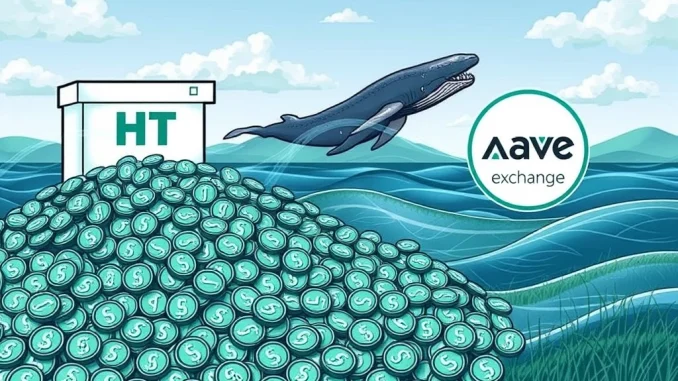
A significant event just hit the crypto wires, catching the attention of market watchers everywhere. According to tracking service Whale Alert, a colossal USDT transfer totaling 200,000,000 USDT, valued at approximately $200 million, has moved from the HTX exchange to the Aave decentralized finance (DeFi) protocol. This isn’t just a routine transaction; moves of this size often signal strategic positioning by a major player, commonly referred to as a crypto whale. What does this massive movement of stablecoins between a centralized exchange and a leading DeFi platform potentially signify? Let’s dive in.
Unpacking the Massive USDT Transfer
The sheer size of this transaction makes it noteworthy. A 200 million USDT transfer represents a substantial amount of capital being deployed or repositioned within the crypto ecosystem. USDT, or Tether, is the largest stablecoin by market capitalization, designed to maintain a 1:1 peg with the US dollar. Its stability makes it a popular asset for moving value quickly between platforms, taking profits, or entering DeFi protocols without the volatility risk associated with assets like Bitcoin or Ethereum.
Such large transfers tracked by services like Whale Alert provide a glimpse into the activities of the market’s biggest participants. While the identity behind the wallet remains unknown, the scale points towards an institutional player, a large fund, or a high-net-worth individual – a true crypto whale.
Meet the Players: HTX and Aave
Understanding the entities involved is crucial to interpreting the potential motives behind the USDT transfer.
- HTX: Formerly known as Huobi, HTX is a major centralized cryptocurrency exchange. Exchanges serve as crucial on-ramps and off-ramps for fiat currency and provide platforms for trading various crypto assets. Moving funds *from* an exchange often suggests the owner intends to use those funds elsewhere, outside the exchange’s direct trading environment.
- Aave: Aave is one of the largest and most established decentralized lending and borrowing protocols built primarily on the Ethereum blockchain (though expanded to others). On Aave, users can deposit crypto assets as collateral to borrow other assets, or they can supply assets to earn interest. It’s a core component of the decentralized finance landscape.
The movement of funds from a centralized exchange like HTX to a decentralized protocol like Aave is a common pattern seen when large holders decide to engage with DeFi opportunities, such as yield farming or providing liquidity.
Decoding the Signal: The Importance of Whale Alert
Services like Whale Alert play a vital role in the transparency of public blockchains. By tracking and reporting large transactions exceeding a certain threshold, they alert the community to significant movements of capital. While these alerts don’t reveal the identity of the participants, they provide data points that market analysts and participants use to:
- Gauge potential market sentiment or upcoming moves.
- Identify periods of increased activity by large holders.
- Track the flow of assets between different parts of the crypto ecosystem (exchanges, DeFi, private wallets).
A report from Whale Alert about a $200 million USDT transfer from HTX to Aave is essentially a signal flare indicating that a major participant is making a strategic move. The challenge lies in interpreting *what* that move means without knowing the whale’s specific intentions.
Is This a Crypto Whale in Action?
Given the scale, it’s highly probable this transaction was executed by a crypto whale. But why would a whale move such a large sum of USDT from an exchange to a DeFi protocol? Several possibilities exist:
- Yield Farming/Lending: The most common reason to deposit stablecoins like USDT into Aave is to earn interest. Aave offers variable interest rates for supplying assets, and 200 million USDT can generate substantial passive income, far exceeding traditional finance options.
- Borrowing Against Collateral: The whale might intend to use the 200 million USDT as collateral on Aave to borrow other assets (like ETH or BTC) without selling their USDT position. This is a common strategy for gaining leverage or acquiring assets for other purposes while maintaining their initial stablecoin holdings.
- Preparing for DeFi Strategies: Aave is interconnected with other DeFi protocols. The USDT might be a first step before engaging in more complex yield farming or liquidity provision strategies across the DeFi landscape.
- Moving Off Exchange: Some whales prefer to hold assets in non-custodial wallets and interact directly with DeFi protocols rather than keeping large sums on a centralized exchange like HTX, perhaps for security reasons or greater control.
Without direct information from the wallet owner, these remain educated possibilities based on typical DeFi behavior observed among large holders.
Implications for DeFi and the Market
A $200 million deposit significantly impacts a protocol like Aave. While Aave handles billions in total value locked (TVL), a deposit of this size:
- Increases the total supply of USDT available for borrowing on Aave.
- Can influence the lending and borrowing interest rates for USDT on the platform (potentially lowering lending rates slightly due to increased supply, or increasing borrowing rates if demand rises to meet the supply).
- Boosts Aave’s overall Total Value Locked (TVL), reinforcing its position as a leading DeFi protocol.
- Highlights continued confidence from large investors in the stability and opportunities within the DeFi sector, despite market volatility.
For the broader market, this USDT transfer serves as a reminder that significant capital is actively moving within the crypto ecosystem, seeking yield and strategic positions. It underscores the growing integration between centralized platforms (like HTX) and decentralized finance (like Aave).
Conclusion: Watching the Whale’s Next Move
The 200 million USDT transfer from HTX to Aave, flagged by Whale Alert, is a classic example of a large-scale crypto whale maneuver. While the exact motive remains speculative, the move strongly suggests an intent to utilize the capital within the decentralized finance ecosystem, likely for lending, borrowing, or related yield-generating activities on Aave. This event reinforces the importance of monitoring large transactions reported by services like Whale Alert as potential indicators of significant capital flows and strategic positioning by market heavyweights. It’s a clear sign that despite market conditions, major players continue to actively engage with both centralized exchanges and decentralized protocols like Aave, constantly seeking the best opportunities for their vast holdings.



